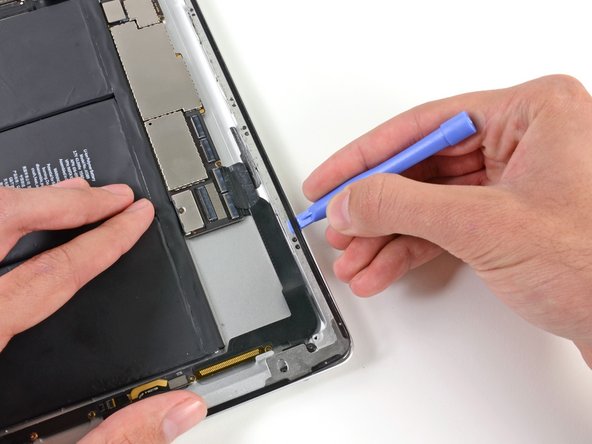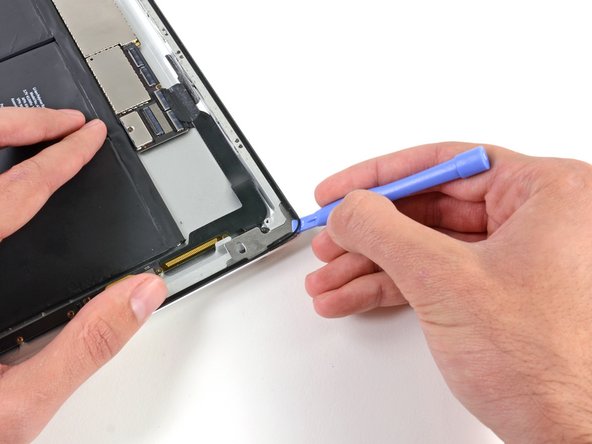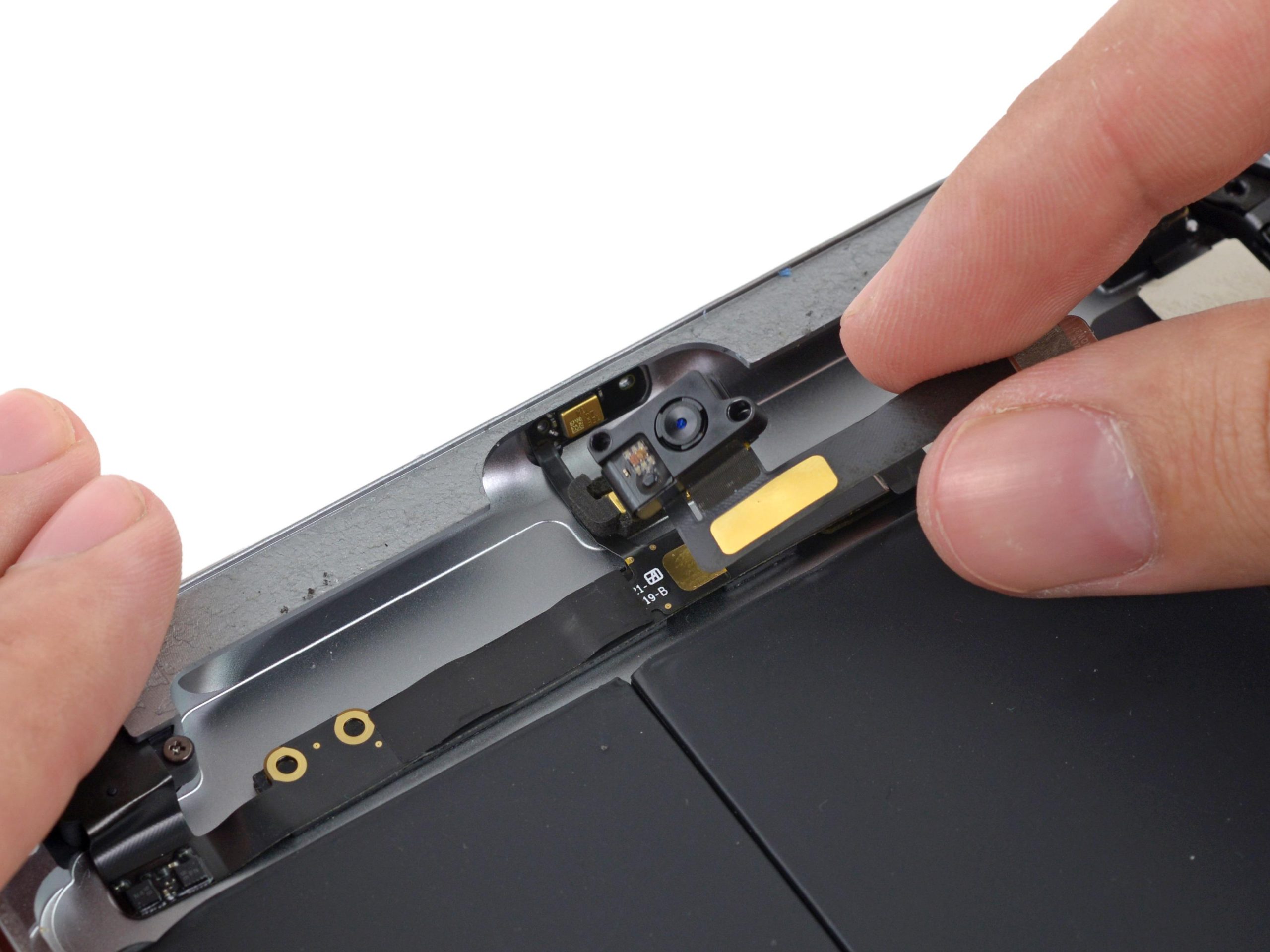How to Replace iPad Wi-Fi Display Bezel Guide
Duration: 45 minutes
Steps: 42 Steps
Hey there! Just a friendly reminder to handle your device with care while you dive into this repair. If you run into any bumps along the way or need an extra hand, feel free to schedule a repair. You’ve got this!
Ready to give your device a fresh new look? This guide will walk you through the process of swapping out that display bezel with ease. Let’s get started on bringing your gadget back to life! And remember, if you need help, you can always schedule a repair.
Step 1
A quick tip before you dive in: give your microwave a little TLC and clean it up! Any pesky residue left behind might just hitch a ride on the iOpener. Let’s keep things tidy and smooth sailing!
– Set the iOpener right in the middle of the microwave.
Tools Used
Step 2
Hey there! Just a quick heads up—make sure not to let the iOpener get too hot while you’re on your repair journey. We wouldn’t want it to go pop! Keep it below 100˚C (212˚F) for everyone’s safety.
If the iOpener looks like it’s been hitting the gym and is a bit puffy, steer clear of touching it.
If the center of the iOpener is still too toasty to handle, keep using it while giving it some time to chill out before you reheat. A perfectly warmed iOpener should stay cozy for up to 10 minutes.
– Give that iOpener a warm-up in the microwave for thirty seconds.
– As you tackle the repair, remember to reheat your iOpener in the microwave for another thirty seconds whenever it starts to cool down.
Tools Used
Step 3
Caution: The iOpener is going to be super toasty, so handle it with care! An oven mitt can be your best friend here.
– Carefully take the iOpener out of the microwave, making sure to grab it by one of the flat ends to steer clear of the toasty center.
Tools Used
Step 4
No microwave? No problem! Just pop that iOpener into some boiling water to heat it up.
– Grab a pot or pan and fill it up with enough water to give your iOpener a nice, cozy bath.
– Heat that water up until it’s boiling, then turn off the heat. Safety first!
– Carefully place your iOpener into the hot water for about 2-3 minutes. Make sure it’s taking a nice dip and is fully submerged.
– Using tongs (because we don’t want any burnt fingers), gently lift the warm iOpener out of the water.
– Give the iOpener a good towel dry. We want it to look sharp!
– All set! Your iOpener is now ready to roll! If it needs a little more warmth later, just repeat the hot water routine for another 2-3 minutes.
Tools Used
Step 5
Pop on those safety glasses to keep your peepers safe, and watch out for that LCD screen – it’s more delicate than it looks!
– If your display glass has decided to crack, let’s keep things safe and sound! Grab some tape and cover that glass to avoid any further breakage or any surprises during your repair journey.
– Lay down some overlapping strips of clear packing tape over the iPad’s display until you’ve got the whole face nicely covered. It’s like giving it a cozy blanket!
– Now, just do your best to follow the rest of the guide as we go along. Remember, once the glass starts cracking, it might want to keep on doing its thing. You may find a metal prying tool handy to help scoop out those pesky glass pieces.
Step 6
Just a quick heads up: while you’re diving into this repair, you might encounter some pesky broken glass. To keep those peepers safe from any flying bits, we totally recommend rocking a pair of safety glasses. Safety first, friends!
– Place the iOpener flat against the right edge of the iPad, making sure it’s smooth and cozy against the surface for a solid connection.
– Give the bag a little time to work its magic on the iPad—about 90 seconds should do the trick—before you dive into opening that front panel.
Tools Used
Step 7
Getting that wedged tip of the opening tool between the glass and plastic might need a little elbow grease. Take your time and be gentle, giving the plastic opening tool a little wiggle as you go. You’ve got this!
– Hey there! Check out that tiny gap in the iPad’s adhesive ring at the upper right corner—it’s about 2.0 inches (~5 cm) from the top. Looks like we’ve found a little opportunity to get started!
– Now, grab your tool and align it with the mute button. Gently slide the tip of a plastic opening tool into that gap between the front glass and the plastic bezel. Just insert the very tip to create a little wiggle room—nothing too crazy!
Step 9
– With the tip of your trusty plastic opening tool snugly positioned between the front glass and the plastic bezel, gently slide a plastic opening pick into that little gap right alongside your tool. You got this!
Step 10
– Take out that trusty plastic opening tool from your iPad, and slide the opening pick a little deeper under the front glass—aim for about half an inch. You’re doing great!
Step 12
The adhesive is super strong, so you might need to put in some serious elbow grease. Just take your time and be careful!
If you can spot the tip of the opening pick sneaking under the front glass, gently pull it out a tad. No worries—using the pick this way won’t cause any harm, but it might leave a little adhesive residue on the LCD. Keep it cool and carry on!
– While the bottom edge is getting cozy with the heat from the iOpener, let’s start peeling back that stubborn adhesive from the right edge of the iPad.
– Gently glide the opening pick down the edge of the iPad, freeing the adhesive bit by bit as you go along.
Tools Used
Step 13
You might need to slide that cozy heated iOpener back to the right edge of your iPad while you gently peel away the adhesive. This little dance depends on how long your iPad has been cooling off while you were busy working your magic.
– If your trusty opening pick gets a little too cozy with the adhesive, just give it a gentle ‘roll’ along the side of the iPad to help it break free and keep on releasing that sticky stuff.
Tools Used
Step 14
– Before you dive in and remove that first opening pick from the bottom corner of your iPad, slide a second pick under the right edge of the front glass. This little buddy will help keep the adhesive from getting all clingy again.
– Give the iOpener a little reheating love, then place it at the top edge of the iPad. Let’s get that adhesive warmed up and ready to cooperate!
Tools Used
Step 15
The Wi-Fi antenna is snugly fastened to the bottom right corner of the iPad’s rear case with screws and a cable. Due to the positioning of the Wi-Fi antenna, it’s super important to handle it carefully; otherwise, you might accidentally cause some serious damage to it.
– Alright, folks! It’s time to tread carefully in the next few steps.
– We need to gently free the adhesive that’s holding the antenna to the front panel. Just remember, we want to keep those delicate parts intact that connect the antenna to the bottom of the iPad. So, let’s take it step by step and keep it smooth!
Step 16
Hey there! Just a friendly reminder: don’t slide that pick past the bottom right corner. You could accidentally mess with the Wi-Fi antenna, and we wouldn’t want that!
– Gently slide that trusty opening pick around the bottom right corner of your iPad, and watch the adhesive let go like it’s saying, ‘See you later!’
Step 17
As you glide that opening pick along the bottom right edge of the front panel, keep your eyes peeled! The Wi-Fi antenna is sneaky and hangs out near the corner, ready to get cut if you accidentally loosen the adhesive the wrong way. Stay sharp!
Just a heads up! Don’t yank that pick out from under the front glass completely. Give it a gentle tug, leaving about 1/8″ (3 mm) of the tip still cozy under there.
– Gently glide the edge of your opening pick along the bottom of the iPad to free up the adhesive around the Wi-Fi antenna. You’ve got this!
Step 18
– Alright, once you’ve breezed past the Wi-Fi antenna (that’s about 3 inches or 75 mm from the right edge, right next to the home button), go ahead and push that opening pick in all the way. You’ve got this!
– Now, slide that pick to the right to free the adhesive holding the Wi-Fi antenna to the front glass. Easy peasy!
Step 19
Keep the iOpener’s heating time to just a minute at a stretch, and give it a breather of at least two minutes before you heat it up again.
If the adhesive has cooled down a bit too much along the bottom edge, give your iOpener another quick heat-up to warm things up where you’re working. Keep it cozy!
– Keep peeling away the adhesive at the bottom of the iPad, and slide that opening pick around the home button. Once you’ve passed the home button, pop it back in to a depth of about 1/2 inch (10 mm). You’ve got this!
Tools Used
Step 20
– Keep peeling that adhesive all the way across the bottom edge of the iPad like a pro.
– Once you’re in, just leave the opening pick snugly under the front glass near the home button. It’s like a little buddy holding the door open for you!
Step 22
If the adhesive has cooled down a bit too much, just swap in the iOpener along the top edge and keep going. If the iOpener itself is feeling a little chilly, give it a reheat and get back to work!
– Gently slide the opening pick along the top edge of your iPad, giving it a little tug to navigate around that front-facing camera bracket.
– This section’s adhesive is pretty tenacious, so you might need to put in a bit of muscle. Take your time and be careful not to slip—your iPad will thank you!
– If the pick feels like it’s stuck in the sticky stuff, try giving it a little roll as shown in step 9.
Tools Used
Step 23
If the adhesive is feeling cozy and warm, go ahead and take the iOpener off the iPad to make things easier. But if it’s still a bit clingy, give the iOpener another heat session and place it on the left edge while you work your magic.
– Keep peeling away that adhesive at the top edge of the iPad, then gently slide the opening pick around the top left corner like a pro!
Tools Used
Step 24
The digitizer cable hangs out about 2″ (50 mm) from the bottom of your iPad. When you’re sliding that pick, take a break and stop when you hit around 2.25″ (60 mm) from the bottom. You’re doing great!
– Gently glide the opening pick along the left edge of your iPad, and watch that pesky adhesive let go! It’s a bit thinner here thanks to the digitizer running along the whole left side. Just remember to keep the pick at a safe depth—no more than 1/2 inch (10 mm)—to keep that digitizer safe and sound. You’ve got this!
Step 25
Be super careful! The bottom of the digitizer cable is just about 1″ (25 mm) from the bottom of your iPad. Take your time and work slowly to avoid accidentally cutting this cable.
– With your trusty opening pick still nestled under the bottom edge of the iPad, gently coax the adhesive loose along the bottom left corner. Keep it cool and steady!
Step 26
It looks like some of the adhesive around the edge of your iPad might have decided to stick around a bit longer than expected. No worries! Just grab a pick and gently slide it under the part where the front glass is still clinging on. Give that adhesive a little snip, and you’ll be back on track in no time!
– Take one of those nifty opening picks and gently pry up the bottom right corner of your iPad. Once you’ve got it popped open, give it a little hug with your fingers to hold it steady!
Step 27
Watch out for any stubborn adhesive that might still be lingering around! Grab an opening pick and gently slice through any sticky spots that are keeping the front panel in place.
– Grab your iPad by the top and bottom right corners and give the front glass a gentle twist away from the device. Easy peasy!
– When you’re putting everything back together, whip out a microfiber cloth and some compressed air to banish any dust or fingerprints from the LCD before you seal the deal with the glass.
Step 28
– Unscrew those four little 2 mm Phillips #00 screws that are holding the LCD snug against the aluminum frame. You’ve got this!
Step 29
– Grab your trusty plastic opening tool or a spudger and gently lift the right edge of the LCD away from the iPad. You’ve got this!
– Now, rotate that LCD along its left edge and carefully lay it down on top of the front panel. Easy peasy!
Tools Used
Step 30
– With the spudger’s tip in hand, gently lift the tape that’s hugging the LCD ribbon cable connector. You’re on the right track!
Tools Used
Step 31
– Gently lift the retaining flap on the LCD ribbon cable ZIF connector, like you’re opening a treasure chest.
– With a little finesse, use your fingers or some tweezers to slide the LCD ribbon cable out of its cozy spot on the logic board.
Step 32
– Carefully lift the LCD off the front panel without touching its surface. You’ve got this!
Step 33
If needed, gently lift the tape that’s holding the digitizer ribbon cable to the logic board. You’ve got this!
– Lift the retaining flap on both of the ZIF connectors for the digitizer ribbon cable with care.
Step 34
– Grab your trusty spudger and gently slide the flat end underneath the adhesive that’s holding down the digitizer ribbon cable. We want to give it a little nudge to help it out!
– With a steady hand, carefully tug on the digitizer ribbon cable and pull it straight out of its cozy sockets on the logic board. Easy does it!
Tools Used
Step 35
– Gently lift the digitizer ribbon cable and grab your trusty spudger to carefully break the adhesive bond holding the cable to the rear aluminum case. You’ve got this!
Tools Used
Step 36
– With a gentle touch, carefully pull the digitizer ribbon cable out of its cozy spot in the aluminum frame.
– Now, go ahead and lift the front panel off the iPad like a pro!
Step 37
– Gently slide the edge of your trusty plastic opening tool right between the plastic and aluminum frames at one of those sneaky corners.
– Carefully glide that plastic opening tool along the iPad’s edge, freeing up the adhesive like a pro.
Step 38
– Keep that momentum going! Glide your trusty plastic opening tool along the entire left edge of the iPad, just like you did before.
Step 39
– As you approach the bottom left corner, give that plastic opening tool a little spin around the edge and keep gliding it along the bottom. You’re doing great!
Step 40
– Keep gliding that trusty plastic opening tool down the right side of the iPad. You’re doing great!
Step 41
– Keep an eye on that front-facing camera as you glide the plastic opening tool along the top edge of your iPad. We want to make sure everything stays in tip-top shape!



























































































